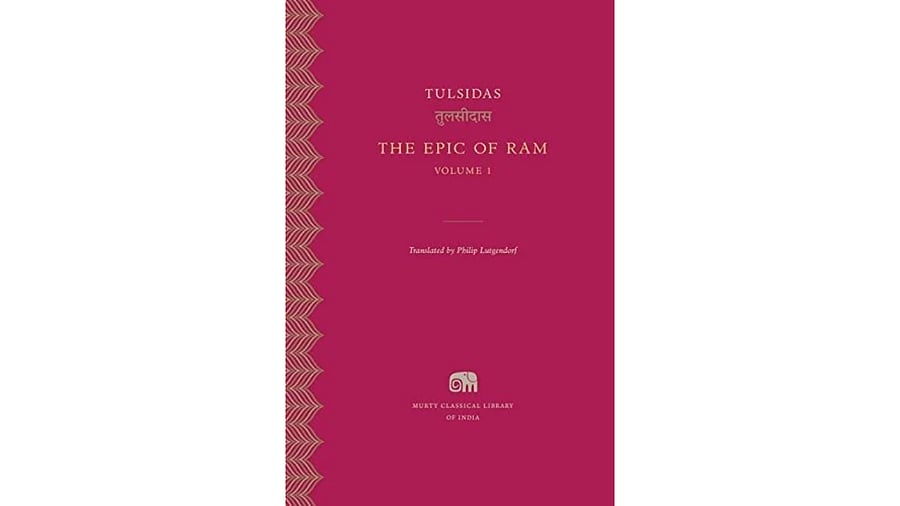
The Epic of Ram
I came to Hanuman through the Ramayana — especially through its captivating Hindi retelling by Tulsidas as the Ramcharitmanas, which I recently had the privilege of translating anew for the Murty Classical Library of India series.
This wasn’t an unusual trajectory. Tulsi himself declared near the end of his epic that “Rama’s servant is greater than Rama himself” (7.120.8) and I had heard a similar sentiment expressed by some of the great scholar-devotees with whom I was fortunate to study in Varanasi and Ayodhya in the 1980s — one pointed out to me how few temples there were to Rama compared with those to Hanuman.
It became a sort of seed-mantra for a research project that, like Hanuman’s own furry appendage, grew and grew through years of pilgrimage, temple darshans, and interaction with numerous devotees. It eventually resulted in a 2007 book that I hope inspires readers to better appreciate Hanuman’s complexity and appeal as a boundary-crossing being who mediates between cosmic categories and offers us humans the possibility of similar transcendence.
Fundamental to this role, I feel, is Hanuman’s monkeyness (kapitva, in Valmiki’s Sanskrit), which stubbornly persists despite the efforts of some modern people to historicise him as a tribal hero or evolutionary “missing link,” or the tendency of some popular poster artists to turn him into a hairless muscleman with gleaming pecs and abs — though even they are obliged to include a simian jaw and tail.
But it is one of the irreducible fundamentals of the Ramayana that its long-suffering hero, who is also god Vishnu incarnate, is ironically obliged to ally himself, to rescue his kidnapped wife and kill her abductor, with a race of forest-dwelling creatures ranked as impure and low in the hierarchical bestiary of classical Indian thought. Of course, these are not ordinary monkeys — although earthly rhesus macaques and (especially) langurs may merit respect today as their distant kin — but demi-divine beings in simian form, spawned by the Vedic celestials to help Rama in his avataric mission. And Hanuman emerges, midway through the story and at a crucial turning point, as the most steadfast and effective of these helpers. His service is not only to Rama but also to Sita, whom he rescues from threatened suicide in the Sundarkand, which earns him, in Tulsi’s version, her blessing of physical vigour and endless life. For his part, Rama confesses a debt to Hanuman that can never be repaid, and devotees have been (so to speak) cashing in on this ever since. For when appealing to any exalted but somewhat distant authority — whether a medieval raja or modern mantri — the easiest way to get one’s petition considered is to submit it to a skilled go-between in the court or office. And the “son of the wind,” who leaps oceans and moves effortlessly between worlds, is also “Rama’s doorkeeper,” as the Hanuman Chalisa (recited daily by millions) famously declares.
These are but a few of the facets of Hanuman’s persona. Other roles must be mentioned, even if only briefly: as a shaman-like healer who rescues Rama and Lakshmana from the murderous clutches of “subterranean Ravana” (Mahiravana) in an old and popular appendage to the main story that is itself a mini-epic — and who continues to help sufferers from mental ills caused by malign “vestiges” of the past (bhuts and prets in traditional terminology) at healing shrines like Mehndipur in Rajasthan. As a paradoxical confluence of self-actualised power and selfless devotion — nicely encapsulated in the rhyming phrase “shakti and bhakti”— Hanuman epitomises and transcends the boundary-straddling role that anthropoid primates have long played for human societies.
Near the end of my Hanuman-yatra, I learned of yet another role for Rama’s messenger: a single, rather eccentric late-20th-century text hailed him as “Lord of Environment and Ecology.” Having witnessed more than half a century of environmental degradation worldwide and in India, I welcomed this and wondered whether others might join Hanuman in fighting these sankats (“afflictions”) that now threaten all life on this planet.
The writer is Emeritus Professor of Hindi and Modern Indian Studies, University of Iowa, and has authored and translated several books, especially related to the Ramayana.
The Heritage Shelf is a monthly column from the Murty Classical Library of India, published by Harvard University Press, presenting India’s greatest literary works and the enduring traditions that shaped them.